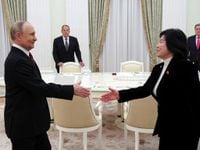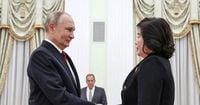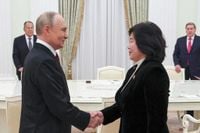On October 27, 2025, the marble halls of the Kremlin bore witness to a meeting that, while steeped in diplomatic ritual, signaled a seismic shift in the global balance of power. North Korea’s Foreign Minister, Choe Son Hui, met with Russian President Vladimir Putin, capping a series of high-level exchanges that have steadily drawn Moscow and Pyongyang closer together amid the ongoing war in Ukraine.
The timing of Choe’s visit was no accident. As Russian troops pressed deeper into eastern Ukraine, including the embattled city of Pokrovsk, and as Western sanctions against Russia’s oil industry tightened, the Kremlin sought to showcase its growing network of allies. North Korea, once isolated and shunned by much of the world, has emerged as Russia’s most significant foreign military partner in the conflict, according to multiple reports from Reuters, the Associated Press, and North Korean state media.
Putin greeted Choe with a warm handshake and a message for North Korean leader Kim Jong Un. “Everything is going according to plan. Please convey my best wishes to him,” Putin said, referencing the leaders’ previous meeting in Beijing during a military parade marking the 80th anniversary of the end of World War II in Asia. According to Reuters, the Russian president emphasized that the “relations and development prospects” between the two countries were progressing smoothly—a sentiment echoed by Choe, who relayed Kim’s “brotherly regard” and “warm wishes” to Putin.
But the cordiality masked a far more consequential reality: North Korea’s commitment to Russia’s war effort has reached unprecedented levels. Since last fall, Pyongyang has dispatched between 10,000 and 15,000 troops to the Ukrainian front lines, according to estimates from South Korea and Ukraine. North Korean artillery, ballistic missiles, and even military construction workers and deminers have bolstered Russian forces, particularly in the strategic Kursk region, where Pyongyang’s soldiers reportedly helped Moscow retake territory after a Ukrainian counteroffensive. North Korean state media acknowledged this involvement as early as April 2025, a rare public admission that underscored the “beginning of a new history of militant solidarity” with Russia, as Kim himself put it during a recent ceremony in Pyongyang honoring fallen North Korean fighters.
The human cost of this alliance has not gone unnoticed. South Korean intelligence estimates that at least 600 North Korean soldiers have died in combat, while some reports put the figure as high as 2,000. Despite the losses, both Moscow and Pyongyang have celebrated what Russian Foreign Minister Sergey Lavrov called the “heroic deeds” of North Korean troops, saying such sacrifices “will further strengthen the bonds of friendship and historical unity in our shared struggle for justice.”
Beyond the battlefield, the partnership has been formalized through a 2024 defense pact committing both nations to mutual military support in the event of “aggression.” This agreement, forged as both countries faced heavy Western sanctions, has deepened technical, economic, and military cooperation. North Korea has received Russian military technology and economic aid in exchange for its support, a development that has raised alarms in Washington. According to the Associated Press, U.S. officials allege that Russia is stepping up technology transfers to North Korea, including in the realm of space and satellite programs—potentially giving Pyongyang a leg up in its longstanding quest for advanced missile capabilities.
For North Korea, the alliance with Russia represents both a lifeline and a strategic opportunity. Kim Jong Un has shunned talks with Washington and Seoul since the collapse of his nuclear diplomacy with then-President Donald Trump in 2019. Now, as he expands the capabilities of his nuclear-armed military, Kim is positioning his country as a key player in a new axis of resistance to U.S. and Western influence. Choe Son Hui, during her Moscow visit, reaffirmed Pyongyang’s “unwavering understanding and support” for Russia’s actions in Ukraine and confirmed North Korea’s backing for “all measures” taken by Russia to defend its security interests and “eliminate the root cause” of the conflict.
Russian officials, for their part, have been equally effusive. During the October 27 meetings, they expressed support for North Korea’s efforts to “firmly defend its current status, security interests, and sovereign rights,” according to the Korean Central News Agency. Both sides discussed expanding high-level exchanges, coordinating their diplomacy on major issues of mutual concern, and pursuing “many future projects to constantly strengthen and develop” the bilateral relationship, though details remain scant.
The deepening Moscow-Pyongyang axis has not gone unchallenged. The United States, under President Donald Trump (now in his second term), has responded with a mix of diplomatic overtures and punitive measures. Trump has repeatedly tried to broker a cease-fire between Russia and Ukraine, but has been rebuffed by Putin, who appears to be betting that Western resolve will eventually falter. Frustrated by the lack of progress, Trump recently imposed sweeping new sanctions on Russia’s top oil producers and signaled that third-party buyers—such as China and India—could also face penalties. These moves, coupled with similar actions by the UK and the EU, have compounded Russia’s economic woes, especially as global oil prices fall and Ukraine’s long-range drone strikes on Russian refineries intensify.
Ukrainian President Volodymyr Zelenskyy, meanwhile, is seeking to capitalize on these developments. He has announced plans to sign three-year contracts with domestic makers of long-range drones and missiles, with funding secured, and has called for more powerful Western weapons, including U.S.-made Tomahawks. Zelenskyy believes that “global sanctions and our pinpoint precision are practically syncing up to end this war on terms fair for Ukraine.” He and EU leaders are working on a cease-fire plan, aiming to present it within a week to ten days—a process that will test both the unity of the Western coalition and the staying power of the Russia-North Korea partnership.
Amid these shifting alliances, Russia is scrambling to maintain its military momentum. Facing recruitment challenges and mounting battlefield losses, Moscow has begun deploying reservists to defend civilian infrastructure and is actively seeking more foreign fighters. North Korea remains its largest supplier of such troops, but whether Pyongyang will send additional forces remains unclear. What is certain is that both Putin and Kim see their alliance as a bulwark against Western pressure—a relationship that, for now, appears to be “going according to plan.”
As the war in Ukraine grinds into its fourth year and the world’s major powers jockey for advantage, the Kremlin’s embrace of Pyongyang stands as a stark reminder: in this conflict, new alliances are being forged, old enmities are hardening, and the stakes—for Ukraine, for Russia, and for the world—have never been higher.


